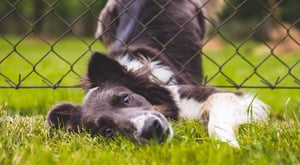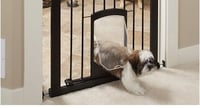A considerable number of people know the joys of having a dog in their life. Whether it was childhood, newlyweds getting a pet together, or adopting a canine after kids come into the picture, interactions between dogs and their humans are quite remarkable.
If you live with dogs, you know something about how they communicate, both verbally and nonverbally. Think about when you put your running shoes on: You are sending a nonverbal signal to your dog that you're going for a jog, and your pooch will likely take that as you asking if he wants to go, too. What does your dog do? Jump for joy or follow you around the house. If you put on your work shoes your dog may sulk, go to her bed, or look sad. When you're having a bad day, you may find your dog appears and puts his head in your lap, seemingly so empathetic to your feelings. You and your dog are engaging in nonverbal communication.
Dogs can also display body language cues that suggest fear, anxiety, worry, and aggression. It's important for dog owners to be able to recognize these cues to mitigate problems down the road.
- Hyper-activity: When dogs are confused about the situation they are in, they tend to jump around and be more vocal than usual.
- Crouching and Growling: Even a friendly stranger may elicit a growl or snarl from a dog, as if to say, "I don't know you, get back, stay away from my owner."
- Destructive behavior: When a dog is left alone, he may destroy the blinds or chew the molding around the door in an apparent attempt to escape and go with his owner. This is often called separation anxiety.
Here are some examples of how dogs express themselves and express these emotional states of anxiety and fear.
The Look Away
 When Kenya is approached by someone that she does not know, she is expressing some very subtle differences in behavior. Since the dog is not at all aggressive, she is showing a difference in behavior that can be easily missed. Most dogs are a bit threatened by a rapid direct approach by a person. Kenya is doing a signal that is called a "look away," where the dog will duck her head. This behavior says, "I mean you no harm, but could we do this differently, could we sit down to gather and get to know each other, could we have a different way of interacting besides this one?"
When Kenya is approached by someone that she does not know, she is expressing some very subtle differences in behavior. Since the dog is not at all aggressive, she is showing a difference in behavior that can be easily missed. Most dogs are a bit threatened by a rapid direct approach by a person. Kenya is doing a signal that is called a "look away," where the dog will duck her head. This behavior says, "I mean you no harm, but could we do this differently, could we sit down to gather and get to know each other, could we have a different way of interacting besides this one?"
Dogs will also get what looks like a worried face. He's beginning to look away, and exhibiting what we sometimes call whale eye. The sclera (the white of the eye) is exposed and the dog's ears are back, this is posturing that suggests anxiety.
The Escape
 Dogs trying to escape will pant excessively while looking for a way out, they might also sit on their owner's feet trying to connect to the owner, and often look at the owner saying, "Will you save me from this situation?" Dogs trying to escape will also yawn. Yawning in dogs is commonly associated with anxiety behaviors.
Dogs trying to escape will pant excessively while looking for a way out, they might also sit on their owner's feet trying to connect to the owner, and often look at the owner saying, "Will you save me from this situation?" Dogs trying to escape will also yawn. Yawning in dogs is commonly associated with anxiety behaviors.
Hiding
 When a dog hides at the approach of a friendly stranger, oftentimes we will see that the dog tucks his tail and has a wide base crouch stance with one paw raised. The raised paw is associated with conflict. The dog is thinking either about escaping or staying with his human. The dog has a very worried face. He's communicating his fear and anxiety. He's moving into the fight-or-flight zone. He may decide that he'd like to make a getaway if he has that opportunity; if he's trapped, he may actually resort to aggression as a way to keep the fearful stimulus away from him.
When a dog hides at the approach of a friendly stranger, oftentimes we will see that the dog tucks his tail and has a wide base crouch stance with one paw raised. The raised paw is associated with conflict. The dog is thinking either about escaping or staying with his human. The dog has a very worried face. He's communicating his fear and anxiety. He's moving into the fight-or-flight zone. He may decide that he'd like to make a getaway if he has that opportunity; if he's trapped, he may actually resort to aggression as a way to keep the fearful stimulus away from him.
Fight Mode
This dog's behavior is also in that domain of fear and anxiety, but he has made a different decision in a fight-or-flight zone; his decision is not to flee, but to fight. This dog is willing to overtly come forward and use aggression, first as a threat like a growl or a snarl. If that does not work, then perhaps he will come forward again in a threatening or dangerous manner.
Managing Anxiety
We see the above listed behaviors on a fairly regular basis during veterinary appointments. To try to ease your pet’s anxiety, we’ve implemented many fear-free techniques to help keep your pet calm during his visit.
- Calming pheromone diffuser in each room
- Pet-calming music plays in every room
- Offering treats
- The colors in the office are very neutral and relaxing
- The doctor and staff often get on the level of the pet
Behaviors in the Home
While you can use some of the above methods in your home to help ease your pet’s anxiety, sometimes the solution for your dog may be a bit more involved. Let's take this scenario: A family has a small dog like a Pomeranian or a Jack Russell terrier, and a three-year-old. Of course, the child is going to want to play with the dog, but the dog isn’t really into it, and sometimes will nip at the child to get the child to stop.
 When a parent is around the child and the dog, the parent notices the dog will freeze in place, maybe snarl a bit. The dog will look at the child and look at the parents trying to communicate, "Save me." This little dog just wants to eat and sleep in peace, but the child wants to play with the dog, pet him, examine his ears, etc. The dog wants nothing to do with this.
When a parent is around the child and the dog, the parent notices the dog will freeze in place, maybe snarl a bit. The dog will look at the child and look at the parents trying to communicate, "Save me." This little dog just wants to eat and sleep in peace, but the child wants to play with the dog, pet him, examine his ears, etc. The dog wants nothing to do with this.
One way to alleviate this issue is to create a safe space just for the dog with his crate, bed, food, and water. The parents put up a gate with an opening just big enough that the dog can get in and out, but the child couldn't pass through. This dog can now go into this area to rest and escape from the three-year-old child.
The effect of this was quite remarkable. Now that the dog knows he can be in his safe space whenever he wants he seems happier. They can now start the process of creating a positive relationship between the dog and the child.
 For small children, they need to learn words that will invoke a positive reaction from the dog, like jump or sit. Every time the dog does this, the child gives the dog a treat, thus creating a positive experience for both. This will create a much safer situation for this child and a much-improved lifestyle for this dog.
For small children, they need to learn words that will invoke a positive reaction from the dog, like jump or sit. Every time the dog does this, the child gives the dog a treat, thus creating a positive experience for both. This will create a much safer situation for this child and a much-improved lifestyle for this dog.
Dogs do tell us what we need to know, so it behooves you to watch your dogs and get to know their body language. Watch for those subtle signs of fear and anxiety, and help them turn negative experiences into positive ones. Dog
